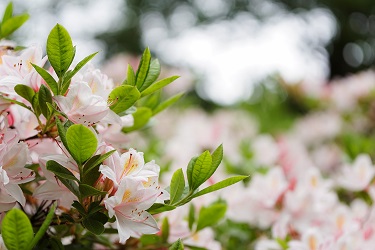Azaleas, Mountain Laurel, & Rhododendron


Azaleas, Mt. Laurel and Rhododendrons are closely related plants with certain cultural requirements that must be met to ensure their successful growth. The following information is provided to help the amateur gardener with the culture of these plants.
PLANTING AND TRANSPLANTING
When planting Azaleas, Mt. Laurel and Rhododendrons, give them ample protection from wind and direct afternoon sun. Around buildings, they do best on the east or north side. In open areas, they like alternating sun and shade. Do not plant them in windy spots. When properly grown they can be transplanted successfully at any time of year if they are given special care in watering and protection from drying and freezing. The ideal time to transplant these plants is during their dormant season, either in the early spring or fall while temperatures are cool and soil moisture is plentiful. If planted in fall erect burlap barrier for winter protection. Plant azaleas, Mt. Laurel or Rhododendrons at the same depth they were growing in the nursery. Spacing will depend on the mature spread of the plants. Many nursery plants are grown in soil mixtures containing large amounts of peat moss or other humus organic matter into the soil around the root ball to ensure good root activity and growth into the soil in your yard.
SOILS
Soils should be well drained and should contain an abundance of organic matter. If heavy clay soils predominate in your yard, plant Azaleas, Mt. Laurel or Rhododendrons on raised beds or establish a drainage system to remove excess water. These plants will not tolerate alkaline (lime) conditions. Keep this in mind when planting around a new home where lime, masonry material, or cement often become mixed with the surrounding soil. This eventually could cause discoloration and death of plants. Work the soil into a good seedbed condition before planting. The addition of leaf mold, peat moss, or other organic matter (such as Bumper Crop) will help almost all soils. When planting, dig a hole twice the size of the root ball. Mix the excavated soil with soil amendments and place enough improved soil in the bottom of the hole so the top of the root ball is slightly higher than the surrounding soil. Fill the hole to the top, watering as you fill to settle the soil and eliminate air pockets. Allow the plant to establish itself in the new location before adding any fertilizer.
FERTILIZERS
Avoid the excessive use of lime or alkaline fertilizers around the plants. We suggest the use of Holly-Tone fertilizer according to label directions. Minor elements such as magnesium and iron may be needed infrequently to add green color to the foliage.
WATER REQUIREMENTS
Azaleas, Mt. Laurel and Rhododendrons have shallow, fibrous root systems, so provide ample water during the summer. If they are planted under wide eave overhangs, furnish water during the entire year. Keep in mind that although these plants need moisture, they will not thrive in wet, poorly aerated soils.
CULTIVATION
Keep cultivation to a minimum because of the shallow root system of these plants. Use mulches to control weeds, conserve moisture, and provide more uniform soil temperatures. Mulches can be made of sawdust, bark dust, peat moss, straw, or other organic materials. If these materials are incorporated into the soil after serving as a mulch, add some nitrogen to assist in decomposition of the woody materials.
WINTER DAMAGE
Winter damage may occur at infrequent intervals, usually due to lack of dormancy in the plant when cold weather occurs. To help development of winter hardiness, avoid adding large amounts of nitrogen after July 15. Some factors affecting the ability of a plant to withstand cold temperatures are length of exposure to low temperatures, rate of temperature fall, extent of plant dormancy, wind and sun exposure, overall condition of the plant, and plant variety.
PRUNING
If new plants are selected properly, taking into consideration mature plant size and space to be filled, little pruning should be necessary. Remove dead and injured branches. If pruning is necessary, prune the plants soon after flowering to allow flower bud formation for the following year. “Dead-heading” is a pruning operation that involves removing spent flower clusters. It should be done annually.
PROBLEMS
Azaleas, Mt. Laurel and Rhododendrons are injured by various types of insects and diseases. Look for the characteristic symptoms of the problem and treat plants promptly with appropriate cultural, biological, mechanical, or chemical methods. Various nutrient disorders will be reflected in foliar symptoms unique for the mineral element deficiency or interaction. In any case, it’s best to check with our gardening experts for controls and problem prevention.
